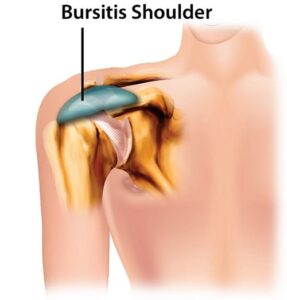The shoulder is one of the most complex joints in the body.
Here’s a breakdown of what you need to know after being diagnosed with shoulder bursitis.
What is shoulder bursitis
The bursa is a fluid filled sac that lies within each of our shoulders. By reducing friction between joints and tendons, it acts as a cushion to the many moving parts that make up the shoulder joint. Injury or inflammation of the bursa results in shoulder bursitis – a painful condition that can present alongside several other conditions, such as rheumatoid arthritis and rotator cuff tear.
What does shoulder bursitis feel like
Shoulder Bursitis can feel slightly different depending on the kind of injury or underlying cause. Often shoulder bursitis presents with tenderness within and around the shoulder, along with a constant ache and difficulty sleeping at night. It can also be partnered with loss of movement, loss of muscle strength, or if appropriate treatment is not sought, frozen shoulder.
Two forms of bursitis exist, acute and chronic, and the presentations of each will manifest differently from one another.
ACUTE bursitis typically arises from direct trauma, infection, or crystalline joint disease, while CHRONIC bursitis is more likely the result of inflammatory issues surrounding the rotator cuff and bicep tendons, and repetitive overuse of these injured muscles and tendons.
Early Signs and Symptoms
Knowing the warning signs and symptoms can be helpful especially if you catch them early and sought treatment. Here are common signs to watch out for that could be associated with bursitis:
- Pain and discomfort around the top of the shoulder
- Warmth and aching around shoulder joint, even weeks after injury
- Tenderness and swelling around the shoulder
- Unable to sleep on the shoulder
- Pain when you’re trying to put a shirt on or lift your arms up
- Difficulty reaching out and pushing things
There are several modalities used for improving pain and ensuring a return to complete functionality. Conservative treatment after an acute traumatic event involves the use of rest and ice for the first 24-48 hours. If you notice symptoms persisting with significant function-loss, assessment from a physiotherapist is likely indicated. In the case where chronic shoulder bursitis has developed, it is highly unlikely that the bursa is the sole cause for your pain or dysfunction. Appropriate assessment by a physiotherapist is recommended to completely understand the causing and relatable factors. Some of these issues can include rotator cuff tear and weakness, stiffness within the shoulder, neck or thoracic spine, weak shoulder blade muscles, or overactive muscle groups.
In addition to rehab provided by your physio, remedial massage can also become part of your treatment plan as it can help to reduce inflammation, increase the range of motion, and improve overall function in the affected area. Massage also helps to reduce stress and anxiety that may be causing or exacerbating the condition.
Catching symptoms early and getting treatment from an appropriate health professional can drastically change the outcome. To book an appointment with one of our physiotherapists click here, or book to see our massage therapist here.


